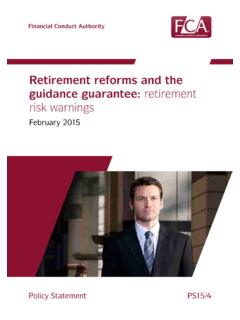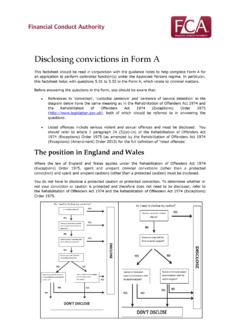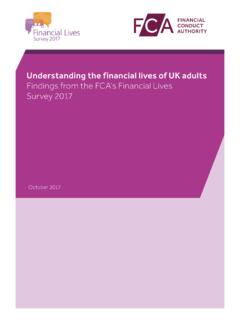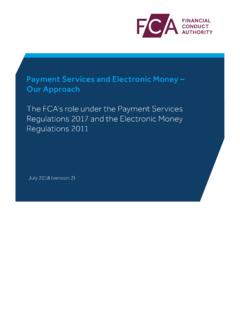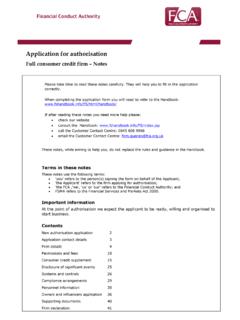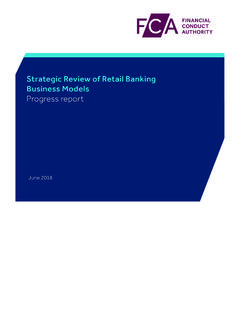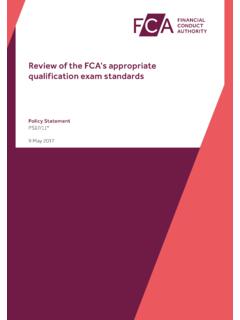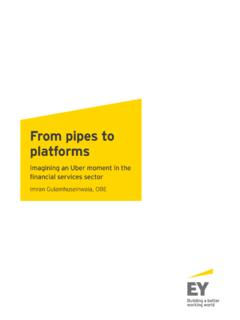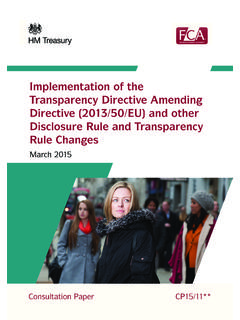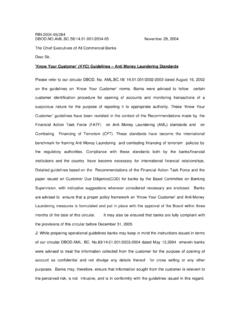Transcription of Banks’ management of high money-laundering risk …
1 Banks management of high money - laundering risk situations How banks deal with high -risk customers (including politically exposed persons), correspondent banking relationships and wire transfersJune 2011 Page 1 Contents 1. Executive Summary Introduction Findings Conclusions 6 2. Introduction Background and objectives Methodology Banks AML legal and regulatory obligations The Wire Transfer Regulations The FSA Handbook 14 3. Findings high risk customers and PEPs AML policies and procedures PEP definition Training and awareness AML policies and procedures examples of good and poor practice Risk assessment Common risk assessment methodology Common weaknesses in risk assessment Risk assessment examples of good practice and poor practice Customer take-on CDD Identification and verification of identity Beneficial owners Identifying PEPs Nature and intended purpose of the business relationship Source of wealth/funds EDD Record-keeping Approval of business relationships Risk appetite.
2 Culture and resources Customer take-on examples of good and poor practice Enhanced monitoring of high -risk relationships Transaction monitoring Regular reviews Enhanced monitoring of high risk relationships examples of good and poor practice 40 Banks management of high money laundering risk situations How banks deal with high -risk customers (including PEPs), correspondent banking relationships and wire transfersPage 24. Findings correspondent banking What is correspondent banking? money - laundering risks in correspondent banking New business origination and strategy Risk assessment of respondent banks Examples of risk-assessment methodology Risk assessment of respondent banks examples of good and poor practice Customer take-on Responsibility for carrying out CDD The quality of CDD Approval of respondent relationships Customer take-on examples of good and poor practice Ongoing monitoring of respondent accounts Transaction monitoring Regular reviews of respondent accounts Ongoing monitoring of respondent accounts examples of good practice and 60 poor practice 5.
3 Findings wire transfers Background Paying Banks Large banks Small banks Paying banks examples of good and poor practice Intermediary banks Large banks Small banks Intermediary banks examples of good and poor practice Beneficiary banks Large banks Small banks Beneficiary banks examples of good and poor practice Implementation of the SWIFT MT202 COV What is the MT202 COV and why was it introduced? The impact on major banks The impact on smaller banks Implementation of SWIFT MT202 COV examples of good and poor practice 756. Case studies high -risk customer relationships 777. Consolidated examples of good and poor practice proposed guidance high -risk customers and PEPs Correspondent banking Wire transfers 93 Banks management of high money laundering risk situations How banks deal with high -risk customers (including PEPs), correspondent banking relationships and wire transfersPage 3 1.
4 Executive Introduction1. This report describes how banks operating in the UK are managing money - laundering risk in higher risk situations. It focuses in particular on correspondent banking relationships, wire transfer payments and high -risk customers including politically exposed persons (PEPs). PEPs are individuals whose prominent position in public life may make them vulnerable to corruption. The definition extends to immediate family members and known close We expect firms to consider our findings and translate them into more effective policies and controls where necessary. This report also outlines proposed guidance , in the form of examples of good and poor practice which, following post-consultation implementation, we will expect firms to take into account. The finalised guidance will be included in Financial Crime: a guide for firms, on which we are currently consulting in CP11/12.
5 If you have any comments on the proposed good and poor practice guidance in this report, please respond to the consultation on the As in any other area of their business, firms should adopt an appropriate, risk-based approach to anti- money laundering , taking into account relevant factors including their customer base, business and risk profile. Failure to do so may result in the FSA taking As a result of this review and our concurrent casework, we have referred two banks to our enforcement division after identifying apparent serious weaknesses in their systems and controls for managing high -risk customers, including PEPs. We are considering whether further regulatory action is required in relation to other banks and further cases may be referred to enforcement. 5. Given the nature of our findings, the management of high -risk customers, including PEPs, will remain a significant focus of our anti-financial crime work for some time to Findings6.
6 Although we identified some examples of good anti- money laundering (AML) risk management , we were concerned to find serious weaknesses common to many firms included in our review. The following are the main findings:Banks management of high money laundering risk situations How banks deal with high -risk customers (including PEPs), correspondent banking relationships and wire transfersPage 4 high -risk customers/PEPs7. Some banks appeared unwilling to turn away, or exit, very profitable business relationships when there appeared to be an unacceptable risk of handling the proceeds of crime. Around a third of banks, including the private banking arms of some major banking groups, appeared willing to accept very high levels of money - laundering risk if the immediate reputational and regulatory risk was Over half the banks we visited failed to apply meaningful enhanced due diligence (EDD) measures in higher risk situations and therefore failed to identify or record adverse information about the customer or the customer s beneficial owner.
7 Around a third of them dismissed serious allegations about their customers without adequate More than a third of banks visited failed to put in place effective measures to identify customers as PEPs. Some banks exclusively relied on commercial PEPs databases, even when there were doubts about their effectiveness or coverage. Some small banks unrealistically claimed their relationship managers (RMs) or overseas offices knew all PEPs in the countries they dealt with. And, in some cases, banks failed to identify customers as PEPs even when it was obvious from the information they held that individuals were holding or had held senior public Three quarters of the banks in our sample failed to take adequate measures to establish the legitimacy of the source of wealth and source of funds to be used in the business relationship.
8 This was of concern in particular where the bank was aware of significant adverse information about the customer s or beneficial owner s integrity. 11. Some banks AML risk-assessment frameworks were not robust. For example, we found evidence of risk matrices allocating inappropriate low-risk scores to high -risk jurisdictions where the bank maintained significant business relationships. This could have led to them not having to apply EDD and monitoring Some banks had inadequate safeguards in place to mitigate RMs conflicts of interest. At more than a quarter of banks visited, RMs appeared to be too close to the customer to take an objective view of the business relationship and many were primarily rewarded on the basis of profit and new business, regardless of their AML At a third of banks visited, the management of customer due diligence records was inadequate and some banks were unable to give us an overview of their high -risk or PEP relationships easily.
9 This seriously impeded these banks ability to assess money laundering risk on a continuing basis. Banks management of high money laundering risk situations How banks deal with high -risk customers (including PEPs), correspondent banking relationships and wire transfersPage 514. Nearly half the banks in our sample failed to review high -risk or PEP relationships regularly. Relevant review forms often contained recycled information year after year, indicating that these banks may not have been taking their obligation to conduct enhanced monitoring of PEP relationships seriously At a few banks, the general AML culture was a concern, with senior management and/or compliance challenging us about the whole point of the AML regime or the need to identify banking16. Some banks conducted good quality AML due diligence and monitoring of relationships, while others, particularly some smaller banks, conducted little and, in some cases, none.
10 In several smaller banks, a tick-box approach to AML due diligence was noted. Many (especially smaller) banks due diligence procedures resembled a paper gathering exercise with no obvious assessment of the information collected; there was also over-reliance on the Wolfsberg Group AML Questionnaire which gives only simple yes or no answers to basic AML questions without making use of the Wolfsberg Principles on correspondent banking. And when reviews of correspondent relationships were conducted, they were often clearly copied and pasted year after year with no apparent Some banks did not carry out due diligence on their parent banks or banks in the same group, even when they were located in a higher risk jurisdiction or there were other factors which increased the risk of money A more risk-based approach is required where PEPs own, direct or control respondent banks.
